
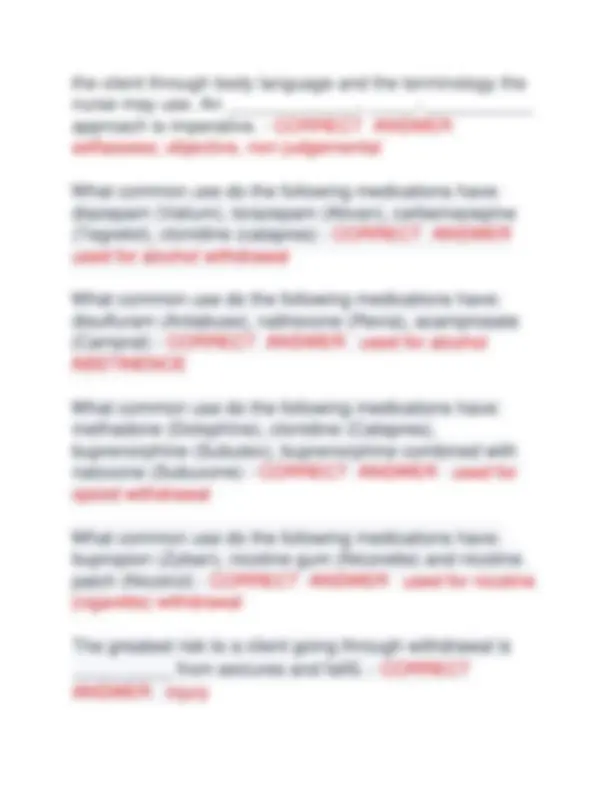
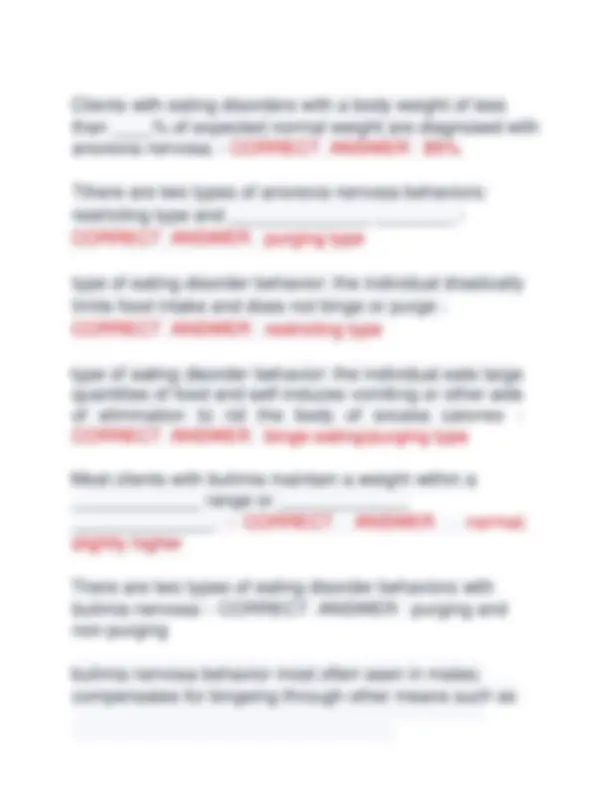
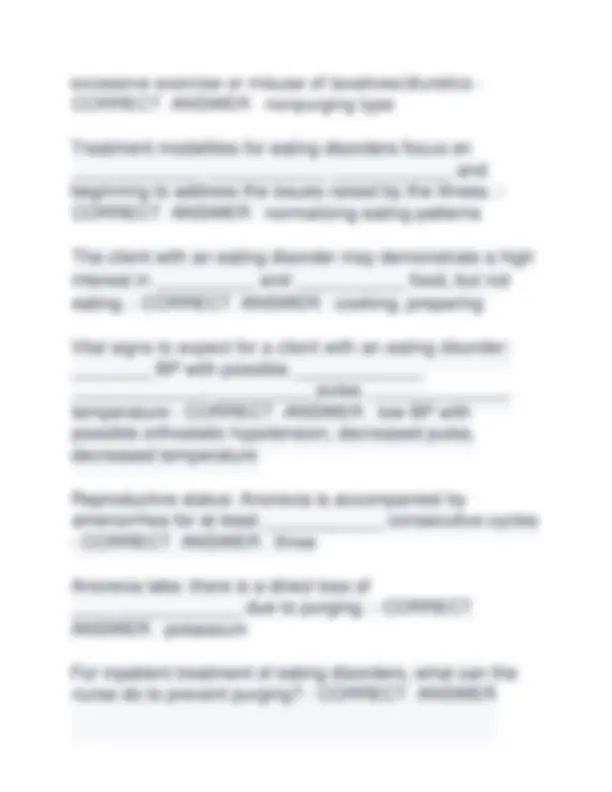
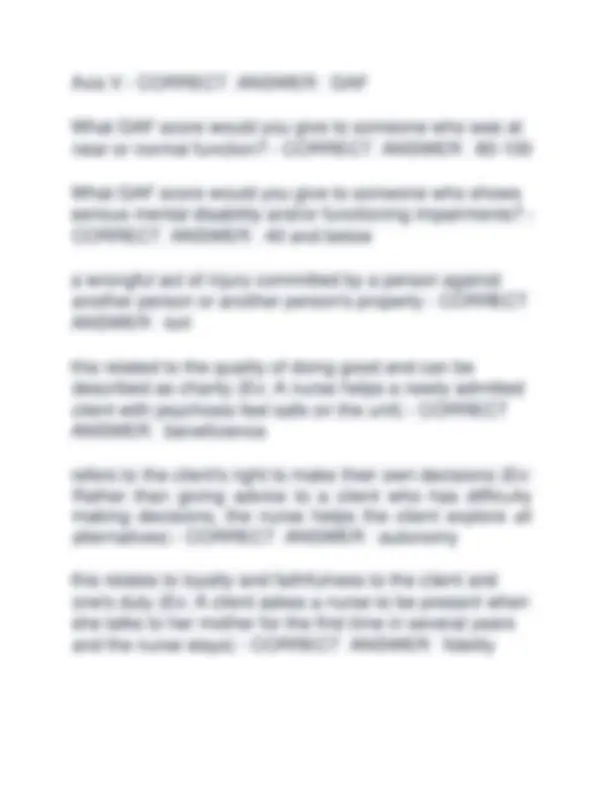
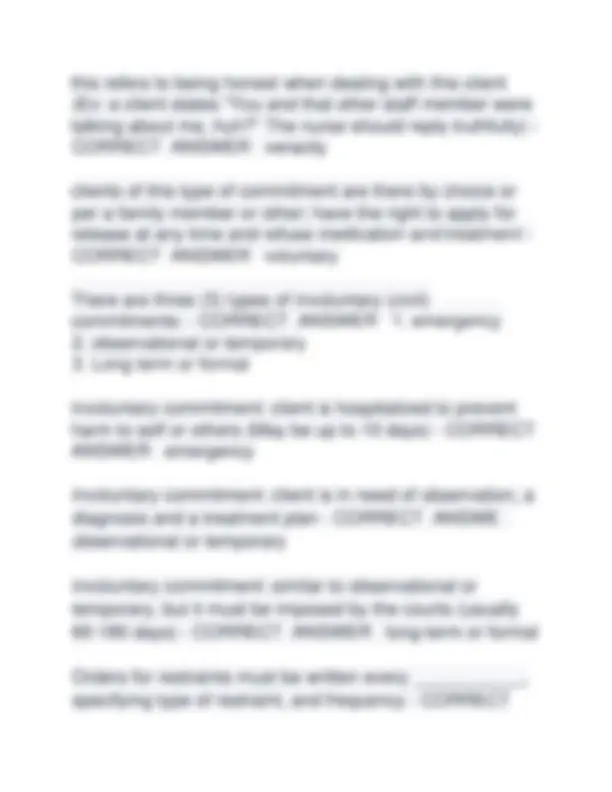
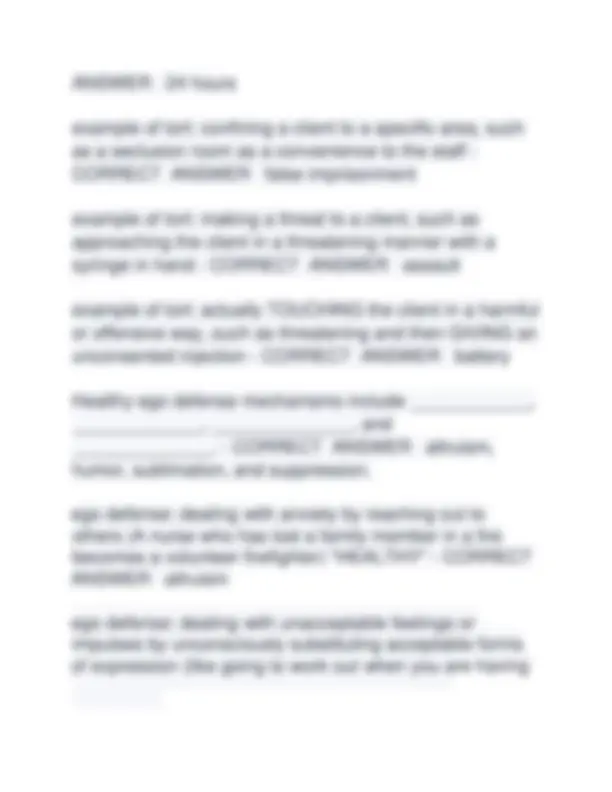
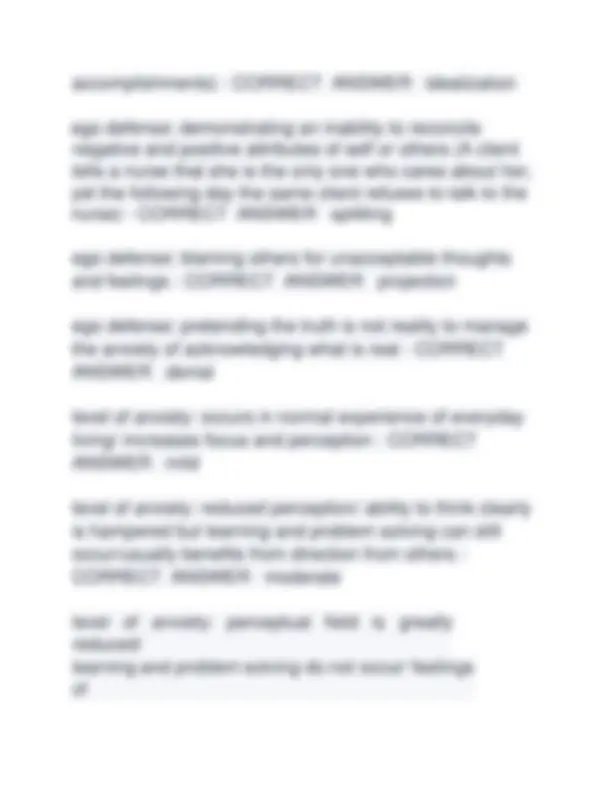
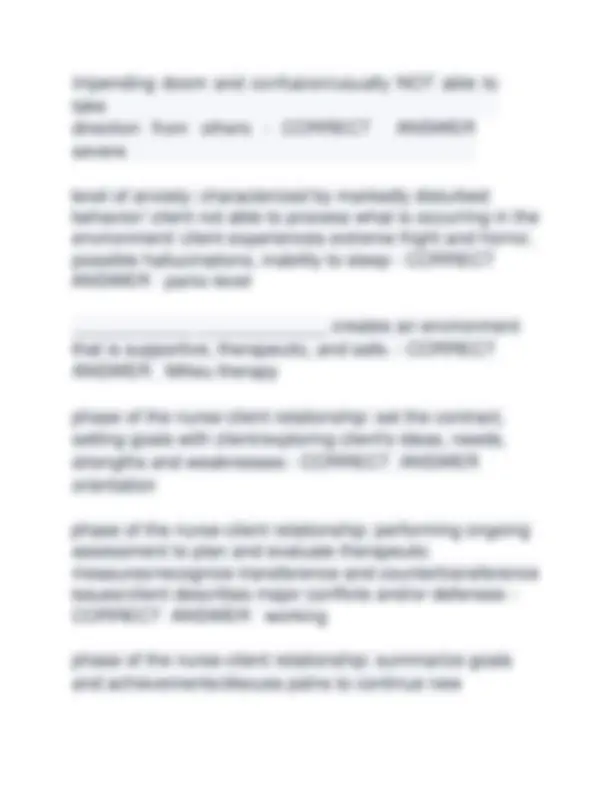
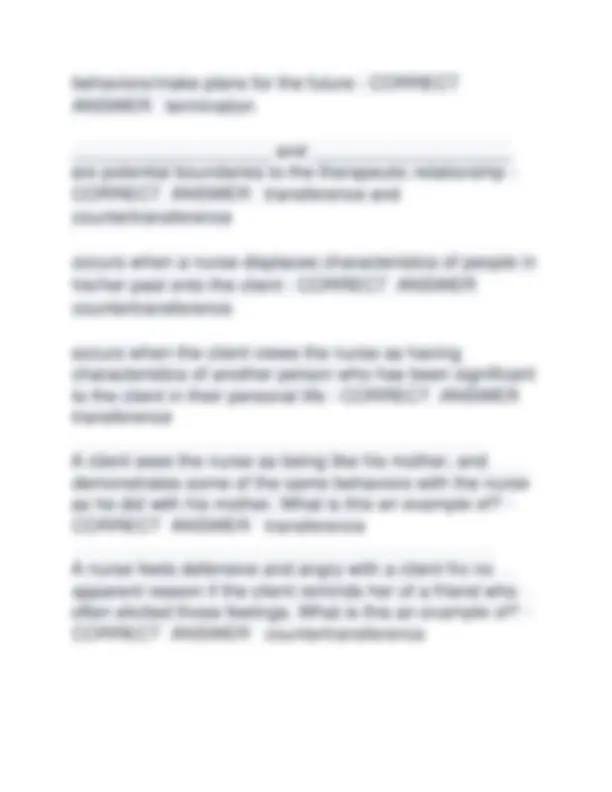
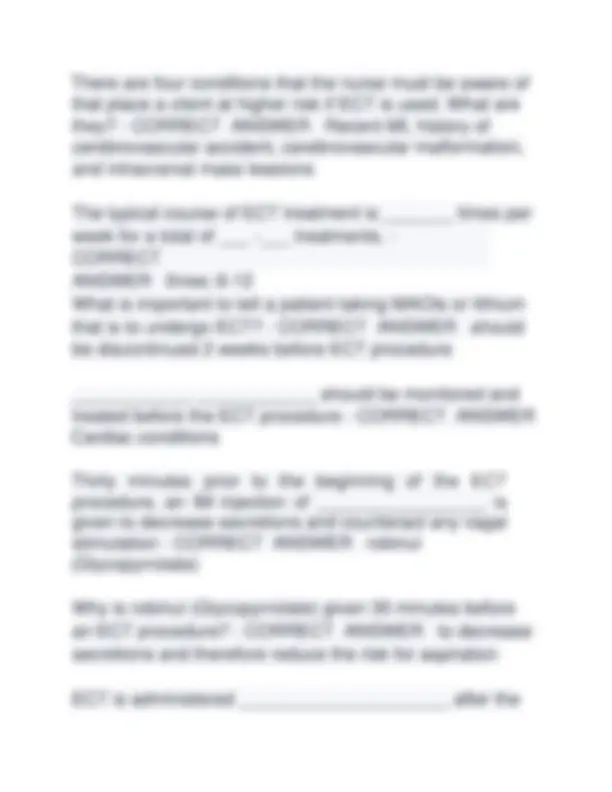
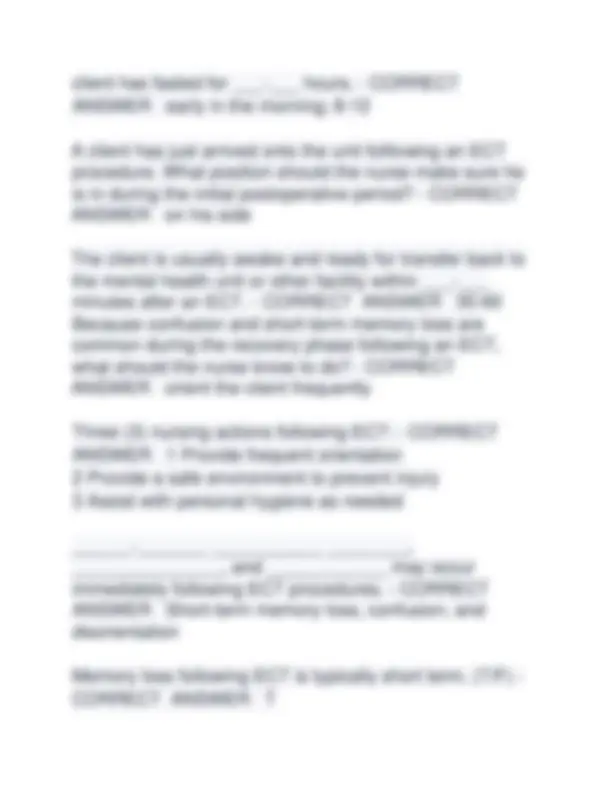
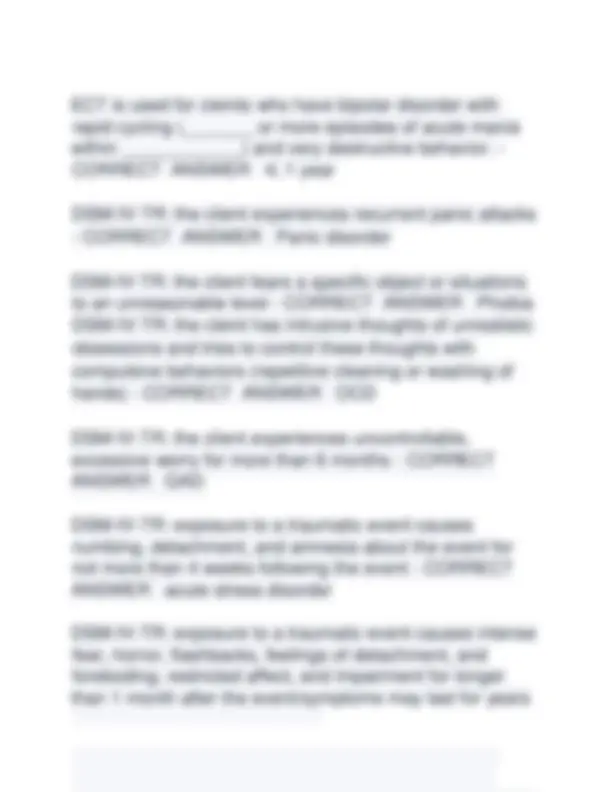
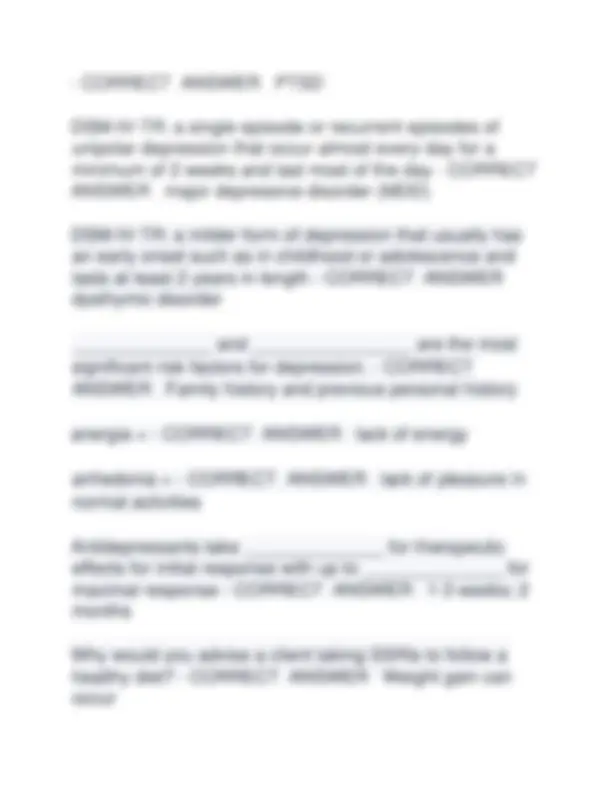
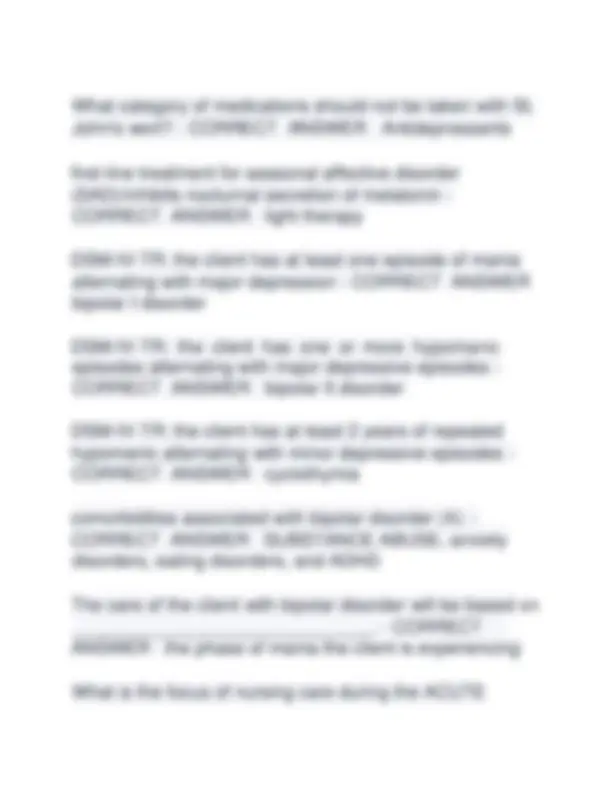
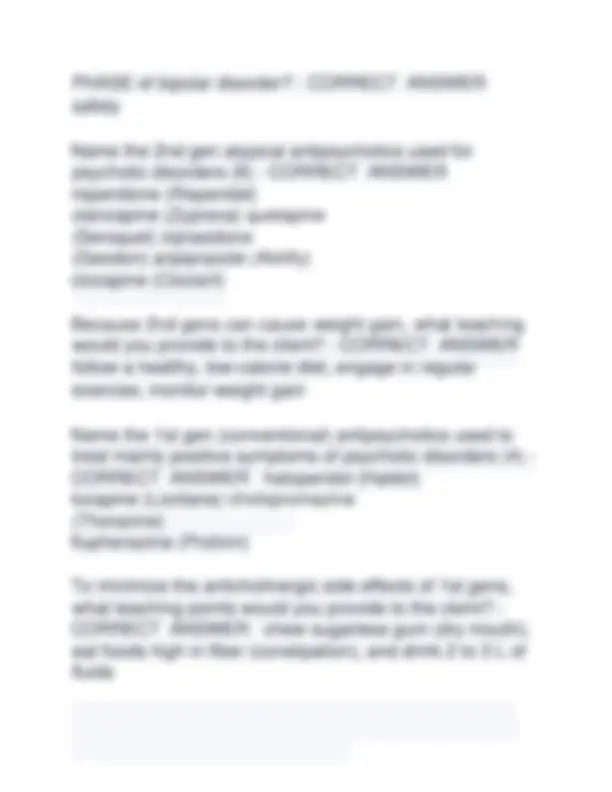
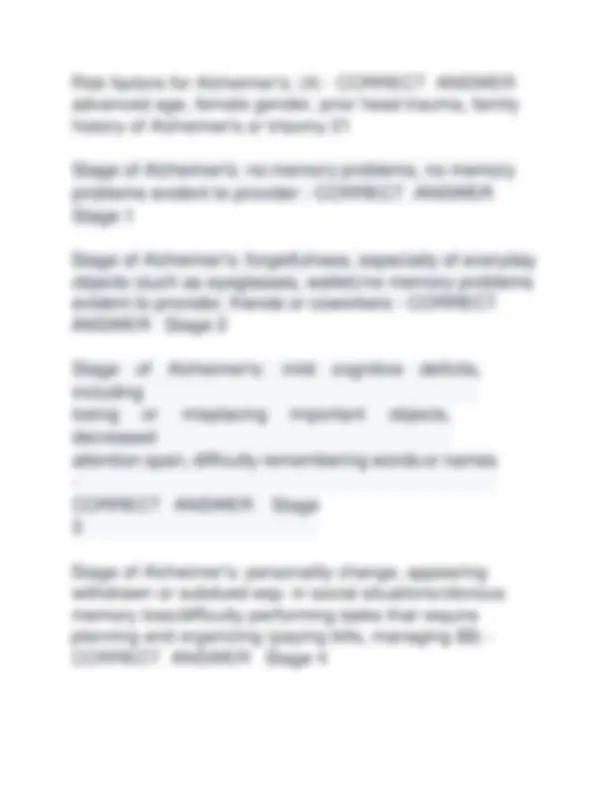
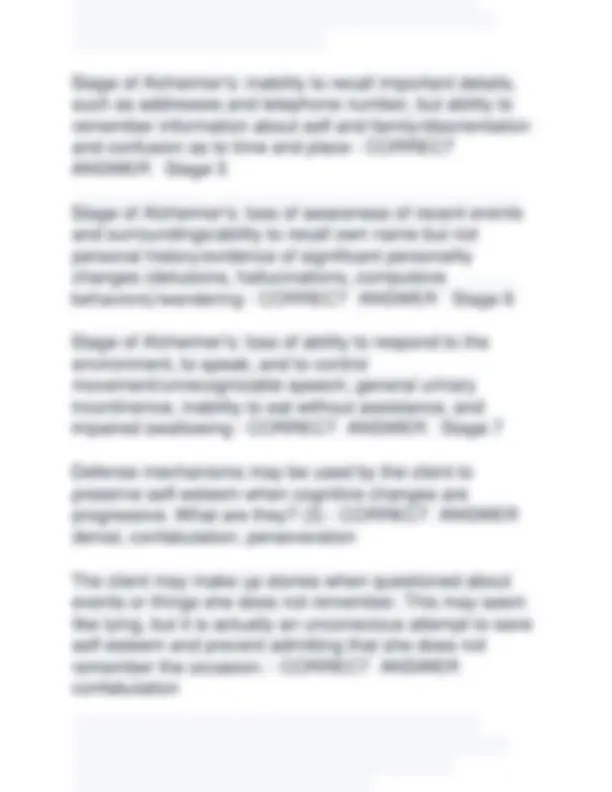
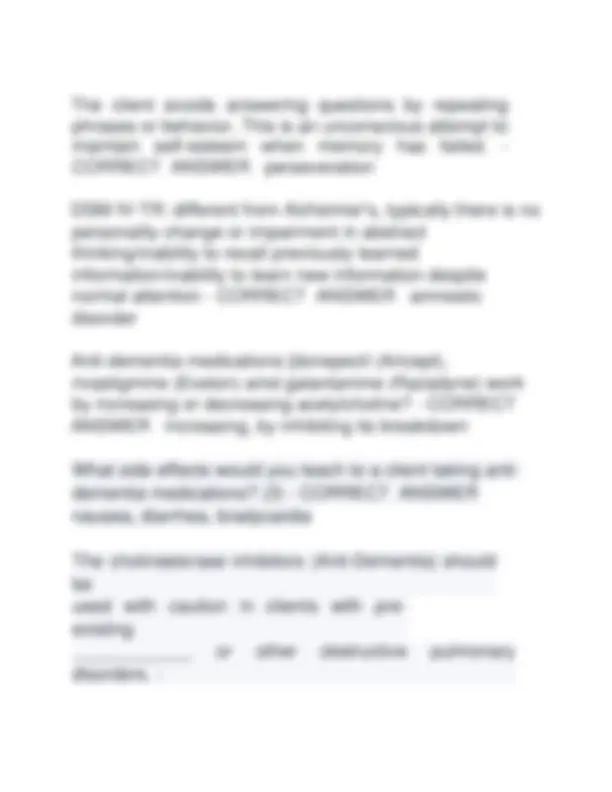
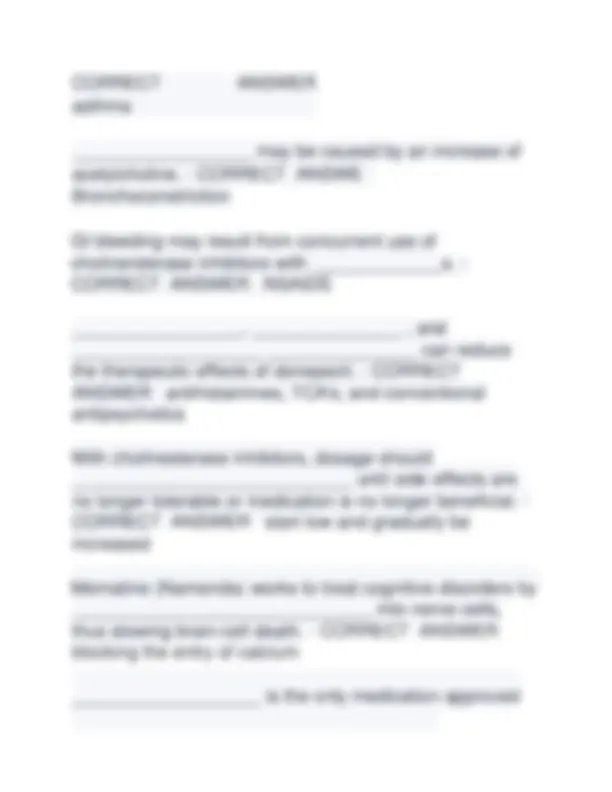
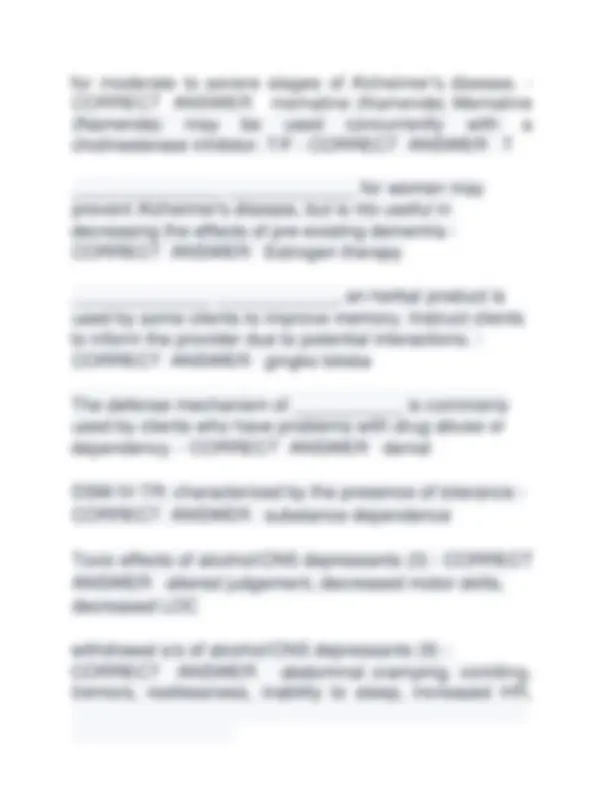
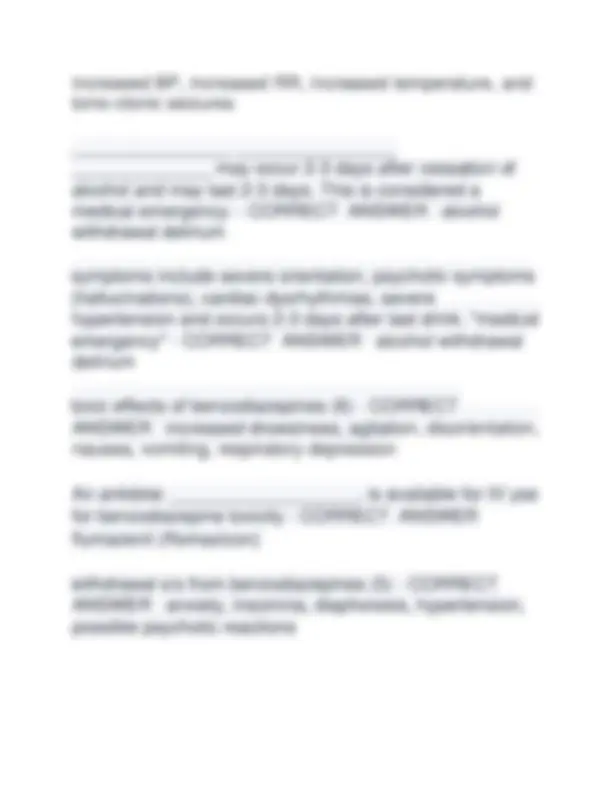


Study with the several resources on Docsity

Earn points by helping other students or get them with a premium plan


Prepare for your exams
Study with the several resources on Docsity

Earn points to download
Earn points by helping other students or get them with a premium plan
Community
Ask the community for help and clear up your study doubts
Discover the best universities in your country according to Docsity users
Free resources
Download our free guides on studying techniques, anxiety management strategies, and thesis advice from Docsity tutors
This document includes the most recent and verified real questions with correct answers from the 2025 ATI Mental Health Exam. It comprehensively covers essential topics such as therapeutic communication, psychiatric disorders, crisis management, psychopharmacology, legal and ethical considerations, and client safety. Perfect for nursing students preparing for ATI exams and NCLEX-style questions focused on mental health.
Typology: Exams
1 / 29

This page cannot be seen from the preview
Don't miss anything!






















The withdrawal signs and symptoms of ________________ are the same as those seen in alcohol withdrawal. - CORRECT ANSWER barbituates How long does it typically take for alcohol withdrawal symptoms to take place? When do they peak? - CORRECT ANSWER 4 - 12 hours after last drink; 24- 48 hours MILD toxic effects of cocaine/CNS stimulants: (4) - CORRECT ANSWER dizziness, irritability, tremors, blurred vision SEVERE toxic effects of cocaine/CNS stimulants: (6) - CORRECT ANSWER hallucinations, seizures, extreme fever, tachycardia, cardiovascular collapse Characteristic withdrawal syndrome from COCAINE: (6) - CORRECT ANSWER depression, fatigue, craving, excessive sleeping or insomnia, dramatic unpleasant dreams, psychomotor retardation or agitation
Characteristic withdrawal syndrome from COCAINE occurs within __ hour to __________ days of cessation of drug use - CORRECT ANSWER 1 hour to several days Is characteristic withdrawal syndrome from COCAINE lifethreatening? - CORRECT ANSWER NO, but there is a risk for suicidal ideation toxic effects from amphetamines - CORRECT ANSWER acute cardiovascular effects (tachycardia, increased BP) which could cause death The withdrawal symptoms from ___________________ are similar to those from cocaine. - CORRECT ANSWER amphetamines An antidote, __________________ is available IV to releive symptoms of opioid overdose - CORRECT ANSWER naloxone (Narcan) Withdrawal from ______________ is very unpleasant, but not life-threatening, and is self-limiting to 7-10 days - CORRECT ANSWER opiods This screening tool asks questions of the client to determine how the client perceives his current substance abuse - CORRECT ANSWER CAGE-AID The nurse must ________-__________ his own feelings regarding abuses as those feelings may be transferred to
Clients with eating disorders with a body weight of less than ____% of expected normal weight are diagnosed with anorexia nervosa. - CORRECT ANSWER 85% Tthere are two types of anorexia nervosa behaviors: restricting type and ______________ ________ - CORRECT ANSWER purging type type of eating disorder behavior: the individual drastically limits food intake and does not binge or purge - CORRECT ANSWER restricting type type of eating disorder behavior: the individual eats large quantities of food and self-induces vomiting or other aids of elimination to rid the body of excess calories - CORRECT ANSWER binge-eating/purging type Most clients with bulimia maintain a weight within a _____________ range or _____________ ______________. - CORRECT ANSWER normal; slightly higher There are two types of eating disorder behaviors with bulimia nervosa: - CORRECT ANSWER purging and non-purging bulimia nervosa behavior most often seen in males; compensates for bingeing through other means such as
excessive exercise or misuse of laxatives/diuretics - CORRECT ANSWER nonpurging type Treatment modalities for eating disorders focus on _____________ ____________ ____________ and beginning to address the issues raised by the illness. - CORRECT ANSWER normalizing eating patterns The client with an eating disorder may demonstrate a high interest in __________ and ___________ food, but not eating. - CORRECT ANSWER cooking, preparing Vital signs to expect for a client with an eating disorder: ________ BP with possible _____________ _____________, __________ pulse, ______________ temperature - CORRECT ANSWER low BP with possible orthostatic hypotension, decreased pulse, decreased temperature Reproductive status: Anorexia is accompanied by amenorrhea for at least ____________ consecutive cycles
Posturing: neck and elbow extension. wrist and finger flexion - CORRECT ANSWER decerebrate rigidity used to objectively assess the client's cognitive status - CORRECT ANSWER Mini-Mental Status Examination used to obtain a baseline assessment of the clients LOC and for ongoing assessment - CORRECT ANSWER Glasgow Come Scale Glasgow Coma Scale: 15 - CORRECT ANSWER highest possible score, awake and responding appropriately Glasgow Come Scale: 3 - CORRECT ANSWER comatose state Axis I - CORRECT ANSWER all mental health diagnoses except personality Axis II - CORRECT ANSWER personality disorders and mental retardation Axis III - CORRECT ANSWER medical diagnoses Axis IV - CORRECT ANSWER pertinent psychosocial problems
Axis V - CORRECT ANSWER GAF What GAF score would you give to someone who was at near or normal function? - CORRECT ANSWER 80 - 100 What GAF score would you give to someone who shows serious mental disability and/or functioning impairments? - CORRECT ANSWER 40 and below a wrongful act of injury committed by a person against another person or another person's property - CORRECT ANSWER tort this related to the quality of doing good and can be described as charity (Ex: A nurse helps a newly admitted client with psychosis feel safe on the unit) - CORRECT ANSWER beneficience refers to the client's right to make their own decisions (Ex: Rather than giving advice to a client who has difficulty making decisions, the nurse helps the client explore all alternatives) - CORRECT ANSWER autonomy this relates to loyalty and faithfulness to the client and one's duty (Ex: A client askes a nurse to be present when she talks to her mother for the first time in several years and the nurse stays) - CORRECT ANSWER fidelity
ANSWER 24 hours example of tort: confining a client to a specific area, such as a seclusion room as a convenience to the staff - CORRECT ANSWER false imprisonment example of tort: making a threat to a client, such as approaching the client in a threatening manner with a syringe in hand - CORRECT ANSWER assault example of tort: actually TOUCHING the client in a harmful or offensive way, such as threatening and then GIVING an unconsented injection - CORRECT ANSWER battery Healthy ego defense mechanisms include ____________, _____________, ______________, and ______________. - CORRECT ANSWER altruism, humor, sublimation, and suppression. ego defense: dealing with anxiety by reaching out to others (A nurse who has lost a family member in a fire becomes a volunteer firefighter) HEALTHY - CORRECT ANSWER altruism ego defense: dealing with unacceptable feelings or impulses by unconsciously substituting acceptable forms of expression (like going to work out when you are having
a bad day) HEALTHY - CORRECT ANSWER sublimation ego defense: voluntarily denying unpleasant thoughts and feelings (A person who lost his job states he will worry about paying his bills next week.) - CORRECT ANSWER supression ego defense: putting unacceptable ideas, thoughts, and emotions out of conscious awareness (A person who has a fear of the dentist's drill continually "forgets" his appts) - CORRECT ANSWER repression ego defense: shifting feelings related to an object, person or situation to another that is less threatening (A person hwo is angry about losing his job comes home and kicks his dog) - CORRECT ANSWER displacement ego defense: developing a physical symptom in place of anxiety - CORRECT ANSWER somatization ego defense: overcompensating or demonstrating the opposite behavior of what is felt (A boy who has a crush on a girl actually teases and humiliates her instead) - CORRECT ANSWER reaction formation ego defense: performing an act to make up for prior behavior - CORRECT ANSWER undoing
accomplishments) - CORRECT ANSWER idealization ego defense: demonstrating an inability to reconcile negative and positive attributes of self or others (A client tells a nurse that she is the only one who cares about her, yet the following day the same client refuses to talk to the nurse) - CORRECT ANSWER splitting ego defense: blaming others for unacceptable thoughts and feelings - CORRECT ANSWER projection ego defense: pretending the truth is not reality to manage the anxiety of acknowledging what is real - CORRECT ANSWER denial level of anxiety: occurs in normal experience of everyday living/ increases focus and perception - CORRECT ANSWER mild level of anxiety: reduced perception/ ability to think clearly is hampered but learning and problem solving can still occur/usually benefits from direction from others - CORRECT ANSWER moderate level of anxiety: perceptual field is greatly reduced/ learning and problem solving do not occur/ feelings of
impending doom and confusion/usually NOT able to take direction from others - CORRECT ANSWER severe level of anxiety: characterized by markedly disturbed behavior/ client not able to process what is occurring in the environment/ client experiences extreme fright and horror, possible hallucinations, inability to sleep - CORRECT ANSWER panic-level ____________ _____________ creates an environment that is supportive, therapeutic, and safe. - CORRECT ANSWER Milieu therapy phase of the nurse-client relationship: set the contract, setting goals with client/exploring client's ideas, needs, strengths and weaknesses - CORRECT ANSWER orientation phase of the nurse-client relationship: performing ongoing assessment to plan and evaluate therapeutic measures/recognize transference and countertransference issues/client describes major conflicts and/or defenses - CORRECT ANSWER working phase of the nurse-client relationship: summarize goals and achievements/discuss palns to continue new
type of behavioral therapy: therapist or others serve as role models for the client, who learns improved behavior by imitation - CORRECT ANSWER modeling type of behavioral therapy: positive rewards are given for positive behavior (reinforcement) - CORRECT ANSWER operant conditioning type of behavioral therapy: the planned, progressive exposure to anxiety-provoking stimuli - CORRECT ANSWER desensitization type of behavioral therapy: a maladaptive behavior is paired with a punishment or unpleasant stimuli to change the behavior - CORRECT ANSWER aversion therapy type of behavioral therapy: teaching a cleint, when negative thoughts or compulsive behaviors arise to say or shout "STOP" and substitute a positive thought - CORRECT ANSWER thought stopping type of behavioral therapy: assists the cleint to change irrational or unrealistic thoughts to thoughts that are more realistic - CORRECT ANSWER cognitive therapy A client thinking he is" a terrible father to my daughter" being helped to change this thinking into "I've made some mistakes as a parent, but I've learned from them and have improved my parenting skills" This is an example of ______________ ________________. - CORRECT
ANSWER cognitive reframing client is guided through a series of images to promote relaxation - CORRECT ANSWER guided imagery A nurse or other healthcare professional trained in this method can assist the cleint to gain voluntary control of such autonomic functions as HR and BP - CORRECT ANSWER biofeedback ______ delivers an electrical current that produces a grand mal seizure. - CORRECT ANSWER Electroconvulsive therapy (ECT) ________ ___________, ______________, and _______ __________ ___________ are indications for ECT (*remember that it is only done after all other treatment options have been unsuccessful) - CORRECT ANSWER severe depression, schitzophrenia, and acute manic episodes Which type of schizophrenia is less responsive to neuroleptics, and therefore are more likely to indicate ECT? - CORRECT ANSWER catatonic schizophrenia What are the contraindications to electroconvulsive therapy (ECT)? - CORRECT ANSWER THERE ARE NONE if it is deemed necessary to save a client's life.
client has fasted for - hours. - CORRECT ANSWER early in the morning; 8- 12 A client has just arrived onto the unit folllowing an ECT procedure. What position should the nurse make sure he is in during the initial postoperative period? - CORRECT ANSWER on his side The client is usually awake and ready for transfer back to the mental health unit or other facility within - minutes after an ECT. - CORRECT ANSWER 30 - 60 Because confusion and short-term memory loss are common during the recovery phase following an ECT, what should the nurse know to do? - CORRECT ANSWER orient the client frequently Three (3) nursing actions following ECT: - CORRECT ANSWER 1 Provide frequent orientation 2 Provide a safe environment to prevent injury 3 Assist with personal hygiene as needed ______-_______ ___________ ________, _______________, and ____________ may occur immediately following ECT procedures. - CORRECT ANSWER Short-term memory loss, confusion, and disorientation Memory loss following ECT is typically short term. (T/F) - CORRECT ANSWER T
ECT is used for cleints who have bipolar disorder with rapid cycling (_______ or more episodes of acute mania within ____________) and very destructive behavior. - CORRECT ANSWER 4; 1 year DSM-IV-TR: the client experiences recurrent panic attacks